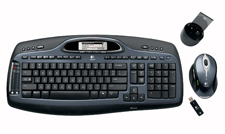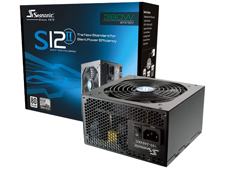Of Mice, Keyboards, and Enclosures
Input devices are one of the more interesting aspects of our roundup as the sheer amount of mice and keyboards available makes it virtually impossible to test every combination. Also, the very subjective nature of testing these devices leads us to always offer the advice of "try before you buy". We decided our best course of action was to select a few of the top selling products and then test their capabilities under Vista. What we found was quite surprising as several of the products proved to us that "Vista Certified" can in fact mean "Vista Disaster".
As an example, for our HTPC platform choice we decided a Bluetooth capable mouse/keyboard combination would offer the best compromise for the sofa users. This led us to the
Microsoft Wireless Entertainment Desktop 7000 and
Logitech Cordless Desktop MX 5000 Laser Combo as our two choices, neither one being anything near inexpensive. What surprised us was the number of issues we had with the Logitech choice. Most of the issues centered on the Logitech having to use the Microsoft Bluetooth stack, but in our opinion there is no way this product should have received the Vista Certified label.
For our standard wireless combinations we selected the
Logitech Cordless Desktop Comfort Laser,
Logitech Cordless Desktop MX 3200 Laser, and the
Microsoft Wireless Optical Desktop 4000. Of course there are multitudes of different wireless keyboards and mice that can be combined together depending upon your likes or dislikes as a user. For simplicity we decided to go the package route - which sometimes works and sometimes doesn't, as we will find out in our separate reviews.
Except for HTPC work, we really prefer the wired keyboards and mice with one of our favorite combinations being the Microsoft
Natural Ergonomic Keyboard 4000 or Microsoft
Comfort Curve Keyboard 2000 paired with the
Logitech MX-518 mouse. We like the MX-518 so much that most of our work desktops use it; it is just that good. As far as our gaming platform is concerned we will test the following keyboards:
Razer Tarantula,
Saitek Eclipse, and of course the
Logitech G15. We will look at
Creative's product lineup later on in the year. Our gaming mice consist of the
Logitech G5,
Razer DeathAdder, and the
Razer Diamondback 3G. Unfortunately, we will have to wait a bit longer before the new Logitech G9 mouse arrives in the labs.
Power supplies are another area where the sheer number of choices and price ranges make it difficult to choose a product. Our thought process in choosing a power supply is to think about the power requirements of your current system and probably the next one or two systems you plan on building. Besides the monitor, the power supply is one of those items that can potentially last through a couple of system builds. We typically tailor our budget to afford the best possible power supply on the market at that time.
Considering our power requirements with the µATX platform are not going to be that great as CrossFire/SLI are out and typically the number of drives and peripherals will be limited by the small form factor, we believe something in the neighborhood of 380W to 480W should be acceptable for now and the near future. We also want a unit that is energy efficient and quiet so our logical choice is the
SeaSonic S12 II 380W. We have not found a combination in our roundup testing yet that would cause us to seek a higher wattage unit. SeaSonic's own S12 II 430W would be the next logical choice but we felt like spending another $25 in this case was not worth it. There are numerous other choices that can made in this sector with Corsair, Enermax, SPI, FSP, and Antec all having good quality power supplies in this range.
We have just about covered the majority of components at this time which leads us to the final stretch. Knowing we are only utilizing the µATX form factor left us with several choices for cases and once again what is one man's garbage is another man's treasure in the hunt for case designs. We typically play it conservative so our choices reflect the decisions made - well almost. For our HTPC platform buildup we decided to break the budget and go with the Zalman
HD160XT. Our gaming platform has two choices, the first being the Thermaltake
LANBOX VF1000 for those who need a solid yet fairly inexpensive portable box. Our second choice and one that broke our budget again is the Silverstone
SG03 SFF tower unit. We felt guilty about the additional credit card charges on our previous case choices so for our general desktop unit we went with the Ultra Products
Micro Fly SX6 case with 600 Watt XVS-Series power supply. Our standard case during the motherboard testing phase was the Silverstone SG03 and we have to admit this is one of our favorite cases at the moment, regardless of form factor.













42 Comments
View All Comments
Mazen - Monday, August 27, 2007 - link
If memory serves me well, we were supposed to see something last week!Mikus42 - Thursday, August 16, 2007 - link
You have great timing! I am researching components for a Micro ATX box.I have an older Shuttle SFF I am going to replace. (It is topped out on CPU speed.)
For me, noise is a very important factor. My shuttle is on my desktop and it can be a tad noisy.
jonp - Thursday, August 9, 2007 - link
The SG03 case is $160 (Newegg) w/o a power supply....ouch.The SX6 w/600w case is $112 (eCost).
I would like to nominate the Foxconn TLM776-CN300C-02 w/300w at $40 (Newegg) as a more typical mini-tower case option.
2 5.25" external -- one more than SG03; same as SX6.
2 3.5" external -- one more than both SG03 and SX6.
4 3.5" internal -- two more than both SG03 and SX6.
expansion slots, front ports same for all three.
power & reset buttons (SX6 yes; not sure if SG03 has reset button).
1 80mm exhaust fan (SG03: 120mm intake, no exhaust; SX6 80mm intake, 120mm exhaust)
Steel (SG03 Al; SX6 steel(?))
The TLM776 power supply is a Channel Well unit. If that doesn't suit then it can be replaced with say a Seasonic S12 II 330watt at $60 for $100 total.
RamIt - Wednesday, August 8, 2007 - link
I am so dissapointed by the numerous delays with this article, i will just pass it up when it finally materalizes. Way too many broken promises Gary.Peace out.
SanLouBlues - Wednesday, August 8, 2007 - link
Since you're dipping your toes in, I'm dying to see some reviews of the PCHDTV cards for linux that claim ATSC/NTSC and unencrypted QAM support.carver5678 - Wednesday, August 8, 2007 - link
here are some suggestions for the review:(1) measure northbridge temps. *lots* of people are having problems with hot NBs. for example, see customer reviews on newegg product pages.
(2) evaluate the ability of the boards to support passive cooling. can the scythe ninja fit on the motherboard? does the board rely on airflow from a cpu cooler to cool its northbridge? can it fit a scythe ninja, thermaright hr-05 NB heatsink, and thermaright hr-03 VGA heatsink, all at the same time, or do they conflict with each other?
lopri - Wednesday, August 8, 2007 - link
I am 200% for the AT's (newer) stance on motherboard evaluations. Contrary to common myth, enthusiast market is HUGE. In various forums I often hear arguments like "Vendors make most money from OEM contracts", "They don't care about enthusiasts. They make money off server market", etc. - this can't be wrong enough. As computers are becoming a commodity, the number of enthusiasts is getting bigger, and vendors are very well aware of this fact. These days we observe even the most conservative and OEM-oriented companies attempt to jump in this growing market and have a piece.And there come the inevitable side-effects: Rushed-out (i.e. bug-fest) products, irrelevant blings, non-functional features, unacceptable compatibility, and poor longevity, etc.
The #1 components in PC, of the said side-effects, are by far motherboards. I have been really put off by today's motherboards and for me it totally ruined the image of "Intel Stability". In all honesty, if I were to be responsible for an on-going support of an Intel based system, there would be only select a few 975X boards to choose from – of course in order to avoid potential hassles . It has been that bad, IMHO, and the ways vendors handle their mishaps are infuriating sometimes. Anyone who had to deal with the so-called "tech support" of famed motherboard manufacturers would know. Even under the best case of scenario, users have to deal with 2~3 weeks of downtime for replacement. (maybe except EVGA) For me, it's a total nonsense.
If you buy a TV, you most likely expect it to work as advertised. Same for a DVD player, refrigerator, or anything that you spend your hard-earned cash on. Not so for a motherboard. It's been such a mystery for me (who happen to be dealing with many professionals and their works/products) how these Taiwanese mobo manufacturers can get away with the poor quality of products they dump in the market, and their shady business practices. When I purchase a product, I should be able to expect a 100% defect-free product, instead of praying on luck. I also don't want to see a almost same product as I bought, being sold with a slightly different name and fixed functions, not too long after my purchase.
To a certain extent, I blame online journalist for their negligence. I do understand many are working with the manufacturers directly to get things right for us and that alone could be a reason why they often are sympathetic with the manufacturers. However, it is important to note that ultimately, reviewers should be in the buyer's shoes, and articles from reputable reviewers can have a huge effect on buyers' decisions. No matter how much work a mobo manufacturer put in, and no matter how much they listened to the reviewers, if the final products that end-users get are not up to the standard (read: 100% free from , reviewers should clearly state the shortcomings of the products at hand.
Above said, I felt so refreshed reading from the first page of this article and would like to commend AT's courage. It's not that AT has been partial or unfair until today - it's the opposite. AT's motherboard reviews are probably the only motherboard reviews (and TechReport's) I've trusted to date and often times I don't even bother to read any other site's reviews. (they are waste of my time) I couldn't be happier with every single sentence that Gary wrote in a clear English. It read almost like a 'motherboard review manifesto 2007' :D and I couldn't agree more with every single word he stated.
SunLord - Wednesday, August 8, 2007 - link
I sure as hell hope you have no plans to recommend the Mx5000 desktop to anyone. It's an unstable pile of crap. The keyboard at random times goes nuts and keys "stick" as you type. They don't stick down but they just keep repeating in windows cause the keyboard has dropped it's signal it's a bluetooth/site point problem. Oh andf can't forget the battery life gotta remember to always turn it off or you'll be replacing batteries every other week. The mouse is nice though.I'm buying a G15 and a rf wireless mouse to replace my month old Mx5000 because it's not worth the hassle of having to pull out and replug in the bt adapter every time the keyboard takes a dump
strikeback03 - Wednesday, August 8, 2007 - link
We have a MX5000 set at work and I have one at home. On the work set it has never dropped the connection, and we have replaced the batteries twice in 15 months (and it sees use for a couple hours a day). The only major problem is that the Logitech software can't handle switching between Linux and Windows, which is why on my home computer I didn't install the Logitech software. I use my home keyboard more, and still get 3 months or so out of decent rechargable batteries.SunLord - Wednesday, August 8, 2007 - link
I exchanged one set after a week and this one is still flacky i just moved to linux 3days ago and while bluetooth is useless it works perfectly. So I'd have to say it's all logitechs fault with there typical craptastic driversOn batteries no clue I burned through 8batteries in a month i bought the same day i got the keyboard at BB... Nice new duracells